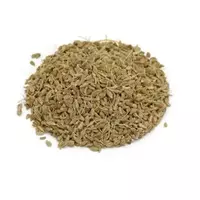Anise

Already in ancient Rome, a spice called anise was known, so we can safely say that it belongs to the most ancient spices that were grown on purpose. According to the chronicles of the Romans - lovers of feasts and libations - it was customary to eat a special tortilla, which contributed to the better digestion of food and prevented bloating. It was prepared on the basis of laurel leaves, and its obligatory component was anise.
In cooking, the English became the first to actively use anise, who began to add this spice when cooking povidl, jams and gingerbread, in which the seeds of this plant were a mandatory ingredient. Interestingly, only anise grains are used for medicinal purposes, while all terrestrial parts of this plant can be used in cooking. For example, fresh anise greens are sometimes placed in salads and in some second courses.
As a fragrant spice, anise, which has a light refreshing aroma, is most often used when preparing various pies, gingerbread, cookies, muffins, pancakes, milk and fruit soups and other delicious dishes.
Often, sea fish are also seasoned with anise - this is mainly inherent in Mediterranean cuisine. The seeds of this spicy plant are flavored by some types of strong alcoholic beverages, and it is customary to add anise oil to sweet alcoholic beverages. Dried anise umbrellas are often used in the manufacture of canned vegetables, as well as in the preparation of various types of meat.
When buying anise seeds for culinary use, special attention should be paid to their appearance, or rather color. The high-quality spice has a light brown tint, the dark color suggests that the seeds were either not collected during the time, or they have been lying on the counter for a long time. In the latter case, we are talking not only about the low quality of the spice, but also about the almost complete absence of any useful properties of anise.
Benefits of anise
The great role of this spice is not only in cooking - the benefits of anise are also known in medicine. So, this spice is quite often used in inflammation of the bladder and kidneys, flatulence, as well as to stimulate the work of the liver and pancreas. Anise-based drugs, including drug collections, are recommended for gastritis and disorders of the normal functioning of the gastrointestinal tract.
The benefits of anise are also contained in oil, which is obtained from the seeds of this spicy plant. Anise oil is sometimes the only effective means in the fight against cathars of the respiratory tract, laryngitis, tracheitis and other respiratory ailments. This oil is often combined with other essential oils - such a mixture has exhilarating properties.
anise 337 kCal
Energy value of anise (Ratio of proteins, fats, carbohydrates - ju):
Proteins: 17.6 (~ 70 kCal)
Fats: 15.9 (~ 143 kCal)
Carbohydrates: 35.42 g (~ 142 kCal)
Energy ratio (bj | y): 21% | 42% | 42%
 Español
Español Français
Français Português
Português Русский
Русский 简体中文
简体中文 繁體中文
繁體中文 日本語
日本語 한국어
한국어 العربية
العربية Türkçe
Türkçe Қазақ
Қазақ Deutsch
Deutsch Italiano
Italiano Українська
Українська
